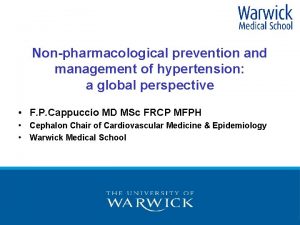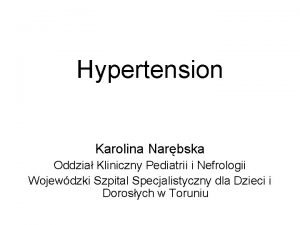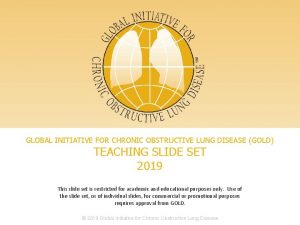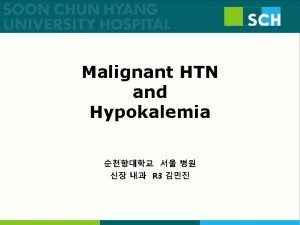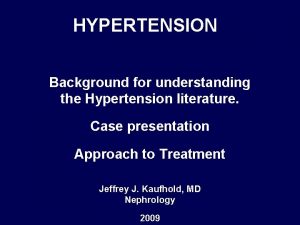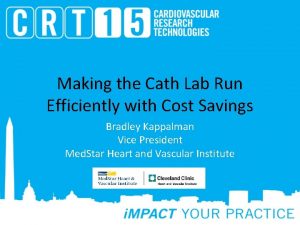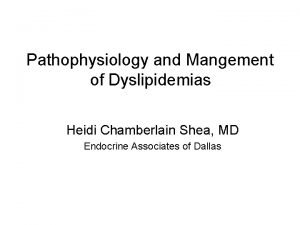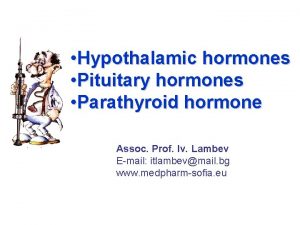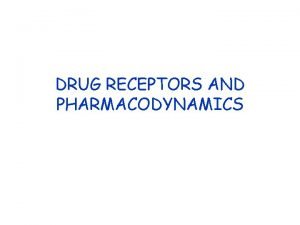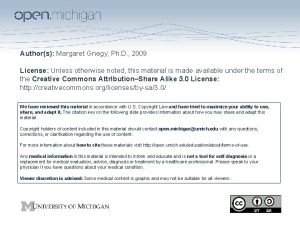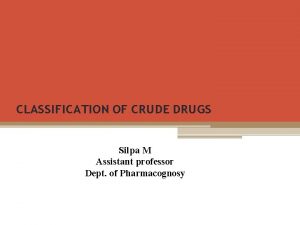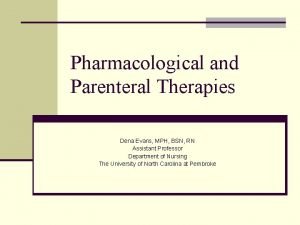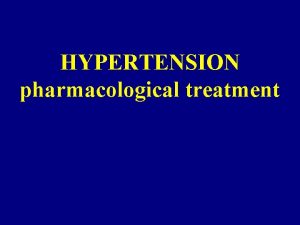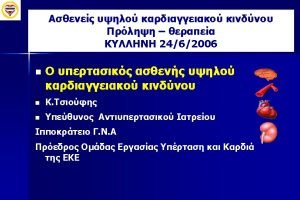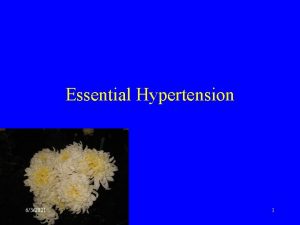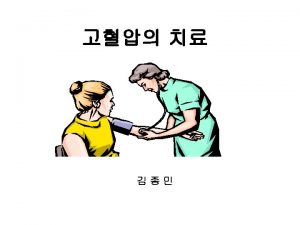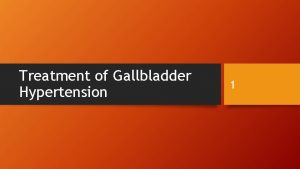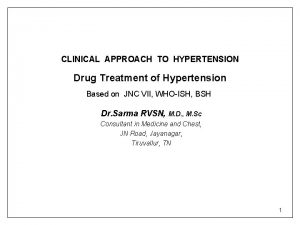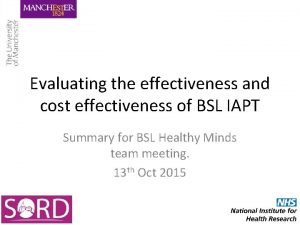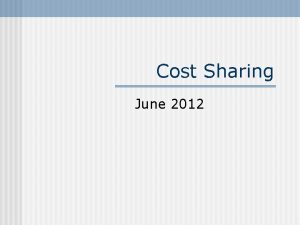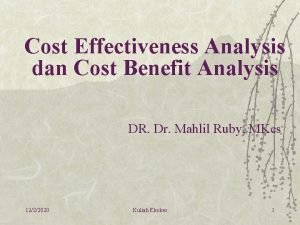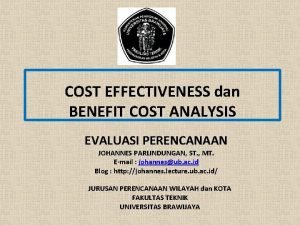Pharmacological Treatment of Hypertension Update 2012 Cost Effectiveness













- Slides: 13

Pharmacological Treatment of Hypertension Update 2012

Cost Effectiveness of Antihypertensive Treatment 2011 “Treating high blood pressure is cheaper than doing nothing”

Step 1 Treatment Recommendations • Offer step 1 antihypertensive treatment with an ACE inhibitor or an ARB to people aged under 55 years. If an ACE inhibitor is used and not tolerated, offer an ARB. [new 2011] • Do not combine an ACE inhibitor with an ARB to treat hypertension. [new 2011] • Offer step 1 antihypertensive treatment with a CCB to people aged 55 years and older and to Black people of African and Caribbean descent of any age. If a CCB is not suitable, for example because of oedema or intolerance, or if there is evidence of heart failure, or a high risk of heart failure, offer a thiazide-like diuretic. [new 2011]

Treatment Recommendations Choice of Diuretic • Which diuretic ? • If a diuretic is required, choose a thiazide-like diuretic, such as chlortalidone (12. 5 mg– 25. 0 mg once daily) or indapamide (1. 5 mg SR, or 2. 5 mg once daily) in preference to a conventional thiazide diuretic such as bendroflumethiazide or hydrochlorthiazide. [new 2011]

Why Change the Diuretic ? • No need to change diuretic in people stable on treatment and in whom BP is controlled; • Evidence review found no evidence in clinical outcome trials of benefits with bendroflumethiazide 2. 5 mg daily; • Most recent trials showing benefits with lower dose diuretics have used thiazide-like diuretics, eg. Indapamide or chlortalidone

Step 2 Treatment Recommendations If step 2 antihypertensive treatment is required, offer a CCB in combination with either an ACE Inhibitor or an ARB. If a CCB is not suitable, for example because of oedema or intolerance, or if there is evidence of heart failure or a high risk of heart failure, offer a thiazide-like diuretic [new 2011]

Step 3 Treatment Recommendations If treatment with three drugs is required, the combination of ACE inhibitor or an ARB, a CCB and a thiazide-like diuretic should be used. [2006]

Step 4 Treatment Recommendations RESISTANT HYPERTENSION Regard clinic blood pressure that remains higher than 140/90 mm. Hg with the optimal or best tolerated doses of an ACE inhibitor or angiotensin-II receptor blocker plus a calcium channel blocker plus a diuretic as resistant hypertension and consider adding a fourth antihypertensive drug and/or seeking expert advice. [new 2011]

Step 4 Treatment Recommendations RESISTANT HYPERTENSION • For treatment of resistant hypertension at step 4, consider further diuretic therapy with low-dose spironolactone (25 mg once daily) if blood potassium levels are lower than 4. 5 mmol/l. Caution is required in patients with impaired renal function who are at higher risk of developing hyperkalaemia. If blood potassium levels are higher than 4. 5 mmol/l, consider therapy with a higher-dose thiazide-like diuretic treatment. [new 2011] • When using further diuretic therapy for resistant hypertension at step 4, monitor blood sodium and potassium and renal function within 1 month and repeat as required thereafter. [new 2011]

Step 4 Treatment Recommendations RESISTANT HYPERTENSION • If further diuretic therapy for resistant hypertension at step 4 is not tolerated, contraindicated or ineffective, consider an alpha- or beta-blocker. [new 2011] • If blood pressure remains uncontrolled with the optimal or maximum tolerated doses of four drugs, seek expert advice if it has not yet been obtained. [new 2011]

Research Recommendations: influencing commissioned research priorities • Out of office monitoring In adults with primary hypertension does the use of out of office monitoring (HBPM or ABPM) improve response to treatment? • Intervention thresholds below 40 years of age In adults with hypertension below the age of 40, what are the appropriate intervention thresholds? • Methods for assessing lifetime CV risk In adults with hypertension below the age of 40 years what is the most accurate method for assessing the lifetime risk of cardiovascular events and impact of therapeutic intervention on this risk?

Research Recommendations: influencing commissioned research priorities • Optimal systolic blood pressure In people with treated hypertension, what is the optimal systolic blood pressure target? • Step 4 treatment – resistant hypertension In adults with hypertension, which drug treatment (diuretic therapy versus step 4 treatments) is the most clinically and cost effective for step 4 treatment? • Blood pressure monitoring equipment In people with hypertension, which is automated blood pressure monitors are suitable for use in people with atrial fibrillation?

NICE Draft Hypertension Guidance: Summary and Reflections • Evolution rather than revolution; • Pragmatic guidance – focus on implementation; • Simpler treatment algorithm; • ABPM for diagnosis is the most controversial aspect; • Change in diuretic will be more straight forward; • Recognition of need to look more closely at younger people before deciding not to treat • On-going discussions regarding QOF targets alignment with NICE guidance
 Hypertension
Hypertension Stage 1 hypertension
Stage 1 hypertension Copd step up
Copd step up Malignant hypertension treatment
Malignant hypertension treatment Malignant hypertension treatment
Malignant hypertension treatment Which is an alternative of log based recovery
Which is an alternative of log based recovery Cost effectiveness constraint
Cost effectiveness constraint Cath lab cost effectiveness
Cath lab cost effectiveness Lipid classification
Lipid classification The pharmacological basis of therapeutics
The pharmacological basis of therapeutics Pharmacodynamics
Pharmacodynamics The pharmacological basis of therapeutics
The pharmacological basis of therapeutics Isapagol
Isapagol Pharmacological and parenteral therapies
Pharmacological and parenteral therapies
